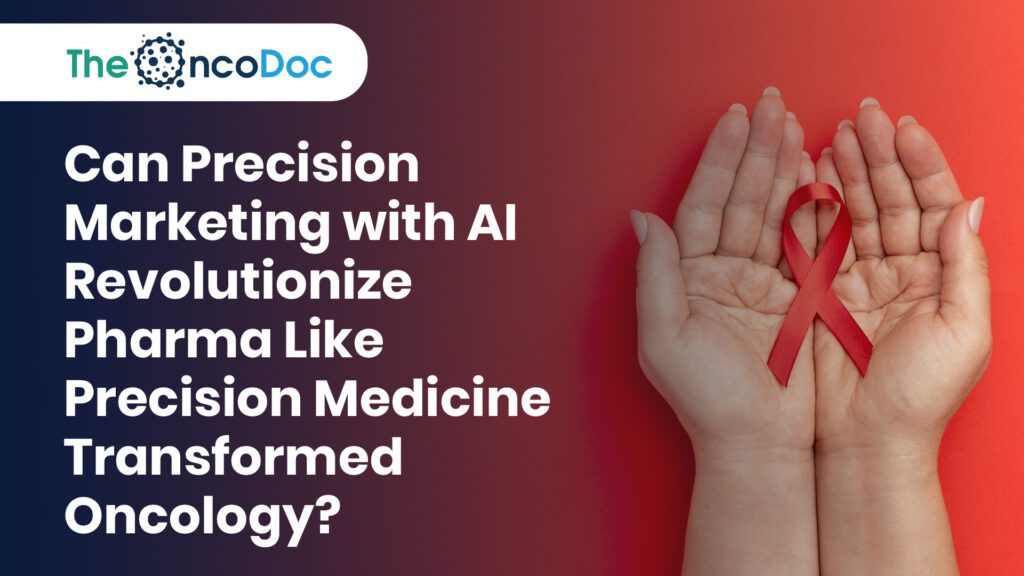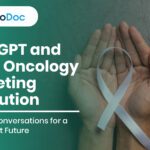Abstract
Precision Medicine has fundamentally reshaped oncology, moving beyond one-size-fits-all treatments to deliver highly targeted therapies based on an individual patient’s unique genetic and molecular profile. This paradigm shift has dramatically improved patient outcomes by ensuring the right treatment reaches the right patient at the right time. Intriguingly, the principles underpinning Precision Medicine – data-driven segmentation, biomarker identification, and tailored intervention – offer a powerful analogy for transforming pharmaceutical marketing. This article explores “The Rise of Precision Marketing with AI,” drawing direct lessons from the success of Precision Medicine, particularly within the US oncology landscape. We posit that just as genetic biomarkers guide therapeutic decisions, digital “behavioral biomarkers” and AI-driven insights can guide marketing strategies to deliver highly personalized, relevant, and impactful engagement to healthcare professionals (HCPs), especially oncologists.
This article provides a comprehensive analysis of how Artificial Intelligence (AI) is enabling this shift towards precision marketing. We examine the core components of AI that facilitate such targeting, including advanced predictive analytics, machine learning for HCP segmentation, natural language processing for content optimization, and omnichannel orchestration. The discussion will highlight how these AI capabilities allow pharma managers to understand individual oncologist preferences, anticipate their informational needs, and deliver tailored scientific and educational content through preferred channels and formats. We will explore the parallels between molecular profiling for patients and digital profiling for HCPs, illustrating how AI can move pharma marketing beyond broad campaigns to truly individualized scientific exchange. The analysis is anchored with data and insights relevant to the US oncology market, offering actionable strategies for pharma managers to leverage AI, elevate engagement effectiveness, and ultimately accelerate the adoption of innovative therapies through truly personalized communication.

Introduction: From Broad Strokes to Targeted Interventions – A Parallel Evolution
For decades, both medicine and marketing operated on a “one-to-many” model. In medicine, this often meant treating all patients with a particular disease with the same therapy, assuming a universal response. In marketing, it translated to mass campaigns, broadcasting the same message to a broad audience, hoping a percentage would resonate. Both approaches, while sometimes effective, were inherently inefficient and often suboptimal.
Then came Precision Medicine. This revolutionary approach, particularly prominent in oncology, transformed cancer care by recognizing the unique molecular signatures of each tumor. Instead of treating “breast cancer,” physicians began treating “HER2-positive breast cancer” or “EGFR-mutated lung cancer,” leading to therapies specifically designed to target those individual characteristics. The result has been a dramatic improvement in efficacy, reduced side effects for non-responders, and a more rational allocation of resources. Precision Medicine is about the right treatment, for the right patient, at the right time.
This article argues that pharmaceutical marketing is on the cusp of a similar transformation, driven by Artificial Intelligence. Just as genetic sequencing provides the data for Precision Medicine, digital behavioral data provides the “biomarkers” for “Precision Marketing.” By borrowing the fundamental lessons from Precision Medicine – the emphasis on granular segmentation, data-driven insights, and highly tailored interventions – pharma can move beyond generic engagement to deliver the right content, to the right oncologist, at the right time, through the right channel.
This piece will bridge the conceptual gap between these two powerful paradigms. We will delve into how AI is enabling this shift in the US oncology market, outlining the methodologies and benefits of applying Precision Medicine’s principles to pharmaceutical marketing. For pharma managers, this represents not just an incremental improvement but a fundamental re-imagining of how to effectively engage with healthcare professionals and accelerate the adoption of life-changing therapies.

Lessons from Precision Medicine: A Blueprint for Marketing Transformation
The success of Precision Medicine in oncology provides a compelling blueprint for how pharmaceutical marketing can evolve. Let’s explore the direct parallels:
1. Biomarker Identification: From Genes to Digital Behaviors
- Precision Medicine: Identifies molecular “biomarkers” (e.g., gene mutations, protein overexpression) in patient tumors that predict response to specific therapies. This data is derived from advanced diagnostics.
- Precision Marketing: Identifies “behavioral biomarkers” or “digital phenotypes” for oncologists. These are data points that predict an oncologist’s likely engagement with specific content, their informational needs, preferred learning styles, and receptiveness to different engagement channels. This data is derived from digital footprints, CRM, and external sources.
- The Parallel: Just as a positive HER2 status guides the use of anti-HER2 therapies, an oncologist’s consistent engagement with articles on novel ADCs in breast cancer, combined with their sub-specialty, indicates a “biomarker” for interest in new therapies for that specific population.
2. Granular Segmentation: From Broad Disease to Specific Patient Profiles
- Precision Medicine: Moves beyond classifying “lung cancer” to identifying specific subsets like “EGFR-mutated NSCLC” or “ALK-rearranged NSCLC.” Treatment is then precisely matched to these granular segments.
- Precision Marketing: Moves beyond segmenting “all oncologists” or even “all breast oncologists” to identifying highly specific groups, such as “academic breast oncologists researching triple-negative breast cancer and actively involved in clinical trials,” or “community oncologists in rural settings managing early-stage HR+/HER2- breast cancer.”
- The Parallel: The more precise the understanding of the target, the more targeted and effective the intervention can be. Generic messaging for “all lung cancer” patients is like generic marketing for “all oncologists” – inefficient and often ineffective.
3. Targeted Intervention: The Right Treatment, The Right Time, The Right Patient
- Precision Medicine: Delivers specific therapies only to patients whose tumors possess the actionable biomarker, significantly increasing efficacy and reducing futile treatment for non-responders.
- Precision Marketing: Delivers highly relevant scientific content, educational resources, and engagement opportunities only to oncologists whose digital phenotype (behavioral biomarkers) indicates a high likelihood of finding that specific information valuable, at a time and through a channel they prefer.
- The Parallel: Wasteful prescribing for non-responsive patients is analogous to wasteful marketing to non-receptive oncologists. Both represent inefficient use of resources and diminished outcomes.
4. Continuous Monitoring and Adaptation: Adjusting Course
- Precision Medicine: Patient response is continuously monitored (e.g., imaging, biomarker levels), and treatment plans are adapted based on efficacy and emerging side effects.
- Precision Marketing: Oncologist engagement is continuously monitored (e.g., content consumption, interaction rates, feedback), and marketing strategies are dynamically adapted based on real-time effectiveness.
- The Parallel: Both paradigms emphasize iterative learning and dynamic adjustment to optimize outcomes.

The Rise of Precision Marketing with AI: Tools and Techniques
Artificial Intelligence is the operational engine that translates the principles of Precision Medicine into actionable Precision Marketing strategies for pharma.
1. AI-Powered Data Aggregation and Behavioral Biomarker Identification
- How AI Works: Machine Learning algorithms can ingest and integrate vast, disparate datasets from internal sources (CRM, marketing automation platforms, medical affairs interactions, website analytics) and external sources (public professional profiles, scientific publications, clinical trial databases, claims data – all anonymized and aggregated). NLP extracts insights from unstructured text.
- Implementation: AI builds a comprehensive “digital profile” for each oncologist. For instance, it can identify an oncologist who consistently reads articles on rare oncogenic fusions, attends virtual scientific exchange meetings, and shows high engagement with content related to targeted therapies in early-stage disease. These are their “behavioral biomarkers.”
2. Advanced HCP Segmentation with Machine Learning
- How AI Works: Instead of manual, rule-based segmentation, ML algorithms perform dynamic clustering, identifying nuanced segments of oncologists based on their behavioral biomarkers, prescribing patterns (where permissible), demographic data, and stated preferences. These segments are far more granular and predictive than traditional methods.
- Implementation: An AI model might identify a segment of “early adopter academic oncologists focusing on immunotherapy in GI cancers” versus “established community oncologists seeking practical management guides for IO-related toxicities in lung cancer.” Each segment then receives highly tailored engagement.
3. Predictive Analytics for Content Relevance and Engagement Timing
- How AI Works: Predictive models analyze historical engagement patterns within specific segments, external events (e.g., ASH, ASCO conferences, new drug approvals), and even real-time market signals to forecast which content is most likely to be relevant and when an oncologist is most receptive to it.
- Implementation: If an AI identifies that a particular oncologist segment tends to engage with short video summaries of clinical trial data right before grand rounds on Tuesday mornings, it will prioritize delivering such content in that format at that time. It can also predict an oncologist’s “next best action” – e.g., if they just viewed a product’s efficacy data, the next logical piece of content might be a safety profile or patient support program details.
4. AI-Driven Content Personalization and Generation
- How AI Works: Generative AI, combined with NLP, can create personalized content variations based on an oncologist’s digital profile. This includes summarizing complex data, drafting initial educational materials, or adapting the tone and focus of messaging for specific segments.
- Implementation: An AI could generate a personalized email for an oncologist, referencing their recent participation in a specific virtual event and offering a link to a related white paper that summarizes new data directly relevant to a challenge they recently posed in an online forum. The AI doesn’t create the scientific data, but it intelligently curates and customizes its presentation.
5. Omnichannel Orchestration and Next Best Action Recommendations
- How AI Works: AI acts as a central brain, coordinating engagement across all channels (email, web, virtual events, sales reps, peer-to-peer platforms). It suggests the “next best action” for each oncologist, whether that’s an email, a personalized web experience, a sales rep visit with a tailored discussion guide, or an invitation to a targeted KOL webinar.
- Implementation: If an oncologist interacts positively with a company’s content on a specific therapy online, AI might suggest to their sales rep to follow up with a deeper dive on that topic, providing the rep with precise insights into the oncologist’s interests, saving time and making the interaction highly valuable. This ensures a coherent, personalized journey.

The US Oncology Market: A Prime Candidate for Precision Marketing
The US oncology market is uniquely positioned to benefit from Precision Marketing with AI:
- High Investment in Precision Medicine: Oncologists are already accustomed to data-driven, personalized approaches to patient care. This mindset makes them more receptive to personalized engagement from pharma.
- Information Overload: The rapid pace of innovation means oncologists are inundated with information. Precision Marketing cuts through the noise by delivering only what is most relevant.
- Diverse Practice Settings: From large academic centers to community clinics, oncologists have varied needs and access to resources. AI enables segmentation down to the individual practice level.
- Regulatory Complexity: Precision Marketing helps ensure that appropriate, relevant information is delivered, reducing the risk of non-compliant, off-target messaging.
- Competitive Landscape: In a crowded market, highly relevant and valuable engagement is a powerful differentiator.

Challenges and Ethical Considerations
Implementing Precision Marketing with AI is not without its hurdles:
- Data Governance and Privacy (HIPAA): The ethical collection, storage, and anonymization of HCP and patient-adjacent data are paramount. Transparency and robust security are non-negotiable.
- Algorithm Bias and Fairness: AI algorithms must be continually monitored to ensure they are not perpetuating biases or excluding certain groups of oncologists.
- Integration Complexity: Integrating AI solutions with existing legacy systems and ensuring data flow across departments (marketing, medical affairs, sales) can be technically challenging.
- Talent Gap: Pharma companies need to invest in data scientists, AI specialists, and marketers who understand these new capabilities.
- Compliance and Oversight: Every aspect of AI-driven content and engagement must be rigorously reviewed by legal, medical, and regulatory teams to ensure adherence to FDA guidelines and other regulations.
- The “Creepy” Factor: While personalization is valued, excessive or poorly executed targeting can feel intrusive. Striking the right balance is key.

Conclusion: The Future is Personalized, for Patients and Physicians Alike
Just as Precision Medicine has transformed the lives of cancer patients by delivering tailored treatments, Precision Marketing, powered by Artificial Intelligence, is poised to revolutionize how pharmaceutical companies engage with oncologists. The analogy is striking: understanding an oncologist’s digital “biomarkers” allows pharma to deliver the “right content, to the right oncologist, at the right time, through the right channel.”
For pharma managers in the US oncology market, this isn’t just an evolutionary step; it’s a paradigm shift. By embracing AI and the principles gleaned from Precision Medicine, they can move beyond generic outreach to foster truly individualized, value-driven scientific exchange. This not only enhances the effectiveness of marketing efforts, optimizes resource allocation, and strengthens relationships with key opinion leaders and practicing oncologists, but ultimately accelerates the adoption of life-saving therapies. In a world where data-driven personalization is the gold standard, the future of oncology engagement is undeniably precise, intelligent, and powered by AI. The time for Precision Marketing is now.
The Oncodoc team is a group of passionate healthcare and marketing professionals dedicated to delivering accurate, engaging, and impactful content. With expertise across medical research, digital strategy, and clinical communication, the team focuses on empowering healthcare professionals and patients alike. Through evidence-based insights and innovative storytelling, Hidoc aims to bridge the gap between medicine and digital engagement, promoting wellness and informed decision-making.



